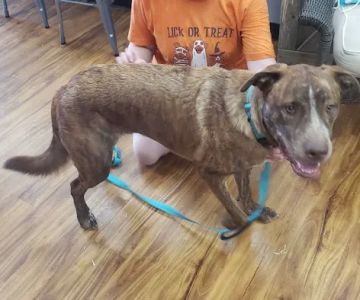How to Teach Your Dog to Perform Basic Agility
As a dog owner, one of the most rewarding activities you can do with your pet is agility training. It not only strengthens your bond with your dog but also keeps them physically and mentally stimulated. I remember the first time I tried agility training with my dog, Max. It was an exciting yet challenging experience, and with a bit of patience and the right approach, we saw incredible results. In this guide, I'll share my personal tips and steps on how to teach your dog to perform basic agility skills, from weaving through poles to jumping over hurdles. Whether you're a seasoned dog trainer or a first-timer, these steps will help you introduce your dog to agility in a fun, effective way.
1. Understand the Basics of Dog Agility
Before jumping into the training process, it’s important to understand what dog agility is all about. Dog agility is a fast-paced sport in which a dog is required to navigate through a series of obstacles, such as jumps, tunnels, weave poles, and seesaws, all while being directed by their handler. The goal is to complete the course as quickly and accurately as possible. Training your dog for agility not only enhances their physical skills but also improves their focus and obedience.
1.1 Benefits of Agility Training
Agility training offers a multitude of benefits for both you and your dog. For starters, it’s an excellent form of exercise. I’ve noticed that after just a few training sessions, Max was more physically fit and had better stamina. It also provides mental stimulation as dogs are required to problem-solve and focus on the tasks at hand. In addition, agility training can help with behavioral issues. By working with your dog on commands and obstacles, they learn self-control and improve their focus, which can lead to better overall behavior.
1.2 Is Agility Right for Your Dog?
Not all dogs are suited for agility training. However, most dogs can learn the basics of agility with time and effort. Dogs that are energetic, playful, and enjoy being active tend to excel in this type of training. Breeds like Border Collies, Australian Shepherds, and Labrador Retrievers are often favorites for agility courses due to their natural athleticism and intelligence. But even if your dog isn’t a high-energy breed, agility training can still be an enjoyable bonding experience and a great way to build their confidence.
2. Preparing Your Dog for Agility Training
Before diving into the actual training, it’s important to prepare your dog. The foundation for any good agility training is a well-trained and obedient dog. Start by working on basic commands such as "sit," "stay," "come," and "heel." These fundamental commands will help in keeping your dog focused during the agility exercises.
2.1 Build Basic Obedience First
As a beginner, I focused on teaching Max the basic obedience commands before introducing agility. These are the building blocks of agility training. Without a solid foundation in obedience, your dog may become distracted, frustrated, or confused while trying to learn more complex tasks. It’s essential to build trust with your dog, so they feel confident and secure when navigating the agility course.
2.2 Get the Right Equipment
For at-home agility training, you don’t need to spend a fortune on professional equipment right away. Start with simple, DIY obstacles like broomsticks for jumps or hula hoops for tunnels. Over time, you can invest in more durable agility equipment. I started with basic equipment that I built myself before upgrading to professional-grade hurdles and weave poles. The key is to make sure the obstacles are safe and appropriate for your dog’s size and skill level.
3. Basic Agility Exercises to Start With
Now that your dog has the basics of obedience and you're ready with the equipment, it’s time to begin training. The best way to start agility training is to begin with simple, easy-to-understand exercises that help your dog build confidence and learn how to navigate obstacles. Here are some basic agility exercises that I found to be effective:
3.1 Jumping Over Hurdles
The first agility exercise I introduced to Max was jumping over hurdles. I started with a very low jump to ensure that Max wouldn’t feel intimidated. Gradually, I raised the height as he gained confidence and improved his jumping technique. To train your dog to jump over hurdles, start by luring them over the bar with treats or their favorite toy. Once they’ve mastered jumping over the low hurdles, increase the height to a level that challenges them without overwhelming them.
3.2 Weaving Through Poles
Weaving through poles is a crucial agility skill that enhances your dog’s agility and coordination. To teach this skill, set up a series of poles (or even broomsticks) in a straight line. Guide your dog through the poles with a treat or a toy, rewarding them every time they make it through successfully. I used positive reinforcement to encourage Max, which helped him stay engaged and motivated throughout the process. Start slow and increase the difficulty as your dog masters the technique.
3.3 Navigating Tunnels
Tunnels are another fun and essential agility obstacle. To teach your dog to run through a tunnel, start by making it short and using treats or toys to encourage your dog to run through. Once your dog is comfortable with the short tunnel, gradually increase the length. Make sure the tunnel is wide enough for your dog to feel safe, and always provide positive reinforcement after they complete the task successfully.
4. Increasing Difficulty and Adding Speed
As your dog becomes more confident in completing the basic agility exercises, it’s time to increase the difficulty. To keep your dog engaged and challenged, you can start adding more obstacles or incorporating additional commands. The goal is to keep the sessions fun and rewarding for your dog. A common mistake I made early on was pushing Max too hard too fast, which led to frustration. Remember that agility is a fun sport and should never feel like a chore for your dog.
4.1 Combining Obstacles
Once your dog is comfortable with individual obstacles, it’s time to combine them into a course. Start with two or three obstacles—such as a jump, a tunnel, and weave poles—and guide your dog through the entire sequence. This will help them learn how to navigate multiple obstacles in one go and improve their speed and accuracy. It also gives them the opportunity to use their problem-solving skills.
4.2 Adding Speed
When your dog has mastered navigating the course with accuracy, it’s time to add speed. Encourage your dog to go faster by using a higher-value reward, such as a favorite toy or more treats. Keep the training sessions short and positive, and don’t forget to celebrate your dog’s progress!
5. Keep the Training Fun and Engaging
Agility training should always be a fun and positive experience for your dog. I found that Max responded best when training was enjoyable and rewarding. Always use positive reinforcement, whether it’s treats, praise, or toys. Avoid punishment or negative reinforcement, as it can lead to confusion and stress. Remember that every dog learns at their own pace, and patience is key. The most important part of agility training is strengthening the bond with your dog while helping them become more confident and physically fit.
If you’re looking to take your dog’s agility training to the next level, consider enrolling in a local agility class or finding an online resource to help you refine your techniques. Agility is a fun and challenging sport that you and your dog can enjoy together, and with the right training, you’ll both see incredible results!











